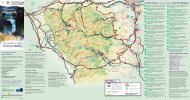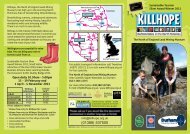How a visit to Killhope can inspire
How a visit to Killhope can inspire
How a visit to Killhope can inspire
You also want an ePaper? Increase the reach of your titles
YUMPU automatically turns print PDFs into web optimized ePapers that Google loves.
• <strong>How</strong> people affect the<br />
environment.<br />
• <strong>How</strong> the features of<br />
localities influence the<br />
nature and location of<br />
human activities.<br />
• To use and interpret maps<br />
and plans.<br />
• To make maps.<br />
Why is <strong>Killhope</strong> like this?<br />
• Divide the children in<strong>to</strong> small<br />
groups <strong>to</strong> complete a survey of<br />
the site and its his<strong>to</strong>ry. Ask<br />
them <strong>to</strong> decide how <strong>to</strong> record<br />
and present their information.<br />
• Ask the children <strong>to</strong> sketch the<br />
site and note the types of<br />
structures, and <strong>to</strong> note what<br />
people do and did.<br />
• Discuss how the features of<br />
<strong>Killhope</strong> affect the nature and<br />
location of human activity there<br />
now.<br />
What does it feel like <strong>to</strong> be here?<br />
• Devise and carry out<br />
their own field<br />
techniques <strong>to</strong> carry out<br />
the survey.<br />
• Understand problems<br />
associated with a <strong>to</strong>urist<br />
site.<br />
• Begin <strong>to</strong> understand how<br />
features of the area<br />
influence human activity.<br />
• To appreciate the quality of<br />
the environment.<br />
• <strong>Killhope</strong> is located in an Area of<br />
outstanding Natural Beauty.<br />
Ask the children <strong>to</strong> sit quietly,<br />
perhaps at the squirrel hide, and<br />
<strong>to</strong> jot down words and phrases<br />
<strong>to</strong> describe how they feel.<br />
Would this change in different<br />
seasons?<br />
• To develop an awareness<br />
of the quality of the<br />
environment and further<br />
develop their sense of<br />
place.<br />
What are the main similarities and differences between our school and <strong>Killhope</strong>? Why are<br />
the places like they are?<br />
• To understand similarities<br />
and differences between<br />
places.<br />
• Ask the children <strong>to</strong> explain the<br />
main similarities and differences<br />
between the two areas.<br />
• Review their fieldwork<br />
experience and reflect on<br />
what they have<br />
discovered and how it<br />
has affected their initial<br />
thinking.<br />
• Understand the<br />
similarities and<br />
differences between the<br />
two localities.<br />
32







